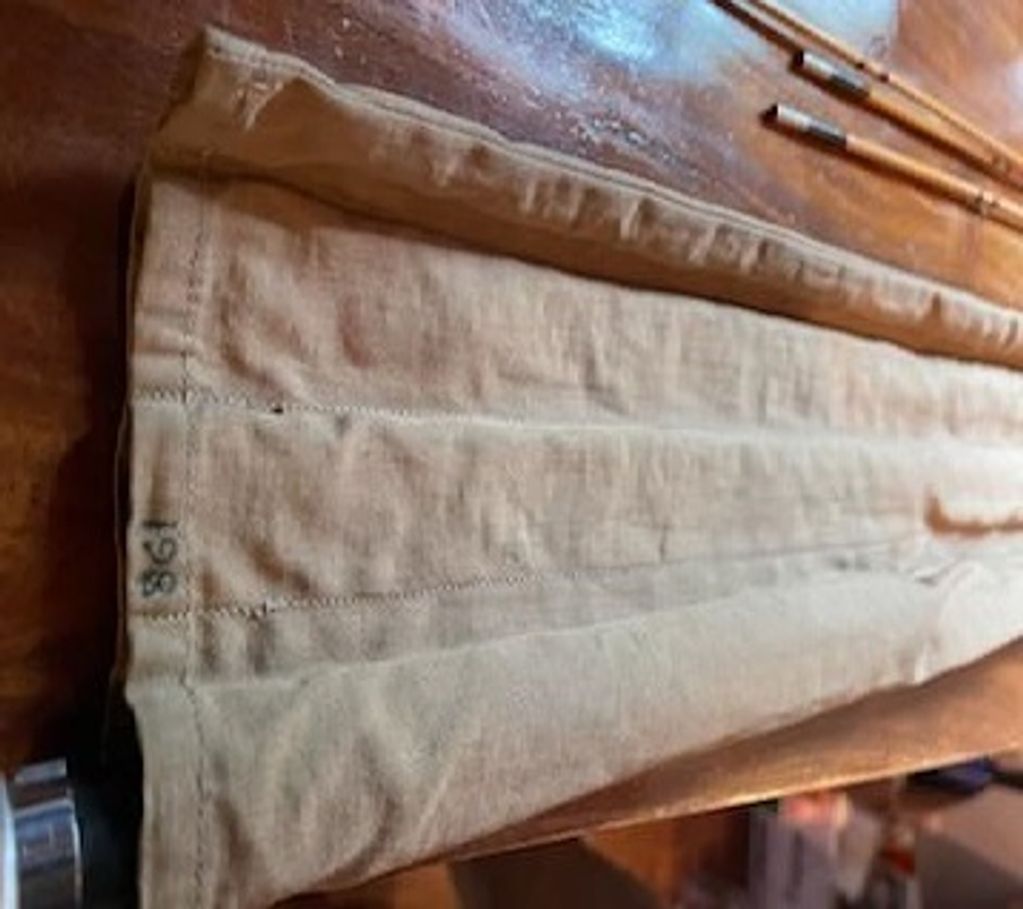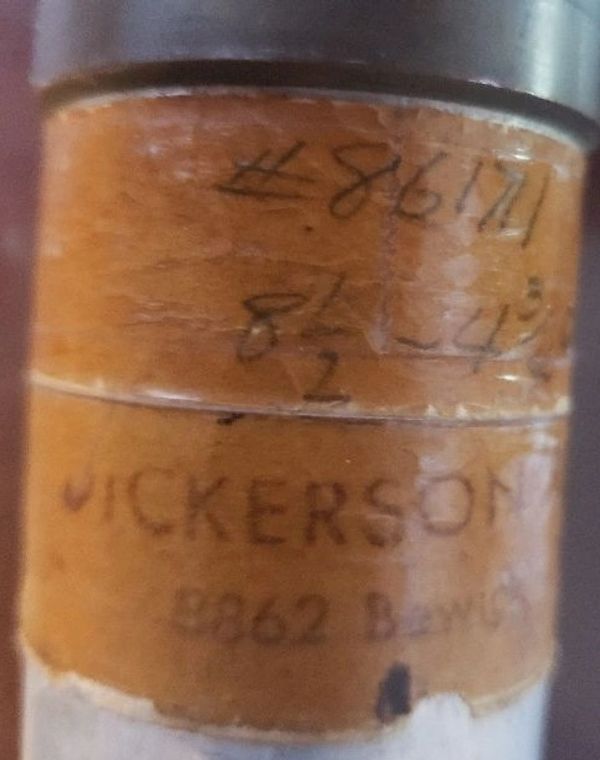Welcome to The Dickerson Site- Updated 10/13/2025, please see News & Updates section
Dickerson rod bags and tubes
Dickerson used a variety of bag and tube combinations over the course of his forty year career. This following is a breakdown of the variations and periods of usage.
Rod bags
Dickerson's are found with several different color bags made in varying thicknesses of material. Dickerson rod bags have fold-over flaps with cloth ties sewn in. The flap is sewn down the middle to create a hood. A very early bag, 1931, has recently surfaced without the hood feature and has been added to this page. It is possible to find bag colors that overlap each other within the timeline. It is assumed Dickerson used the newer color bags with the most popular rod sizes when he ran out of the old color. The most commonly seen bags usually are found with at least two different color ties.
(1) First era (1931) bag. This is a recent surfacing of a Dickerson rod bag type not previously seen. It is a straightforward four compartment khaki colored bag and an extremely early example. It is from an 8’6” three piece rod made in Dickerson’s first year of production in 1931. It accompanies rod 862, which is the second 8’6” Dickerson made and the 7th rod overall. Dickerson’s very early rod marking system was to write the length of the rod followed by a sequential number of that particular length of rod made. For example, 861 is the first 8’6” rod Dickerson ever made, 862 is the second, and so on… This bag is marked 861, even though it is with rod 862. I’m not sure why this is, but according to the records, rod 861 and 862 were made at the same time. It is not clear, at this time, how long this style bag was used.
(2) 1930's bag: Dickerson's early common bag with material ranging from light gold to light tan. These bags feature the thickest material he ever used. Generally, the ties are a slightly darker shade of the bag material; light gold bag/gold ties, light tan bag/tan ties. This bag was used beginning in the early 1930s and is seen with rods made until around 1940.
(3) Dark/army green bag with dark green or brown ties. This bag was used from the early 1940's until about 1950 and featured sturdy material.
(4 /4a) Olive-light beige bag with tan ties (photo 3)or green ties (photo 3a) used from 1950 into the mid 1960s. The material can appear olive-gray depending on fading or possibly varying material batches. This bag has thinner material than Dickerson's other bags.
(5) Tan bag with green or brown ties was used occasionally in the early 1950s and is not very common. Sturdy material.
(6) An example of a two compartment Dickerson bag for a 7'2" spinning rod marked "S" on the inside of the flap.
(7) Black bag with light green ties. This bag houses a rod marked as made in 1970.
Towards the end of Dickerson's rod making years, late 60's/early 70s, it seems as though rod bags were made with whatever color material was on-hand. Various colors can be found, some might be one of a kind. Confirmed are: reddish-brown bag with dark green ties, late 1960s. Dark blue bag with green ties, early 1970s.
A high percentage of Dickerson's 1930s bags had rod information written on the inside or the outside of the hood flap. An example of how the script might appear is shown in the photo (upper right).
Many of Dickerson's post-war bags have the rod length listed inside the hood, such as 8 (eight foot rod). It is assumed this was for ease of sorting through his stock of bags when pairing with a finished rod. Photo below shown as final bag example.

Dickerson 1930s rod bag with model information written the the flap

(1) 1931 bag from Dickerson's 1st year of production. It is a four compartment bag of khaki color. Photos courtesy of Doug T.

(1) First era (1931) bag. Another angle of the recently surfaced Dickerson rod bag style not previously seen.

(2) 1930's light gold with gold ties

(3) 1940s dark/army green bag with brown ties

(4) olive-light tan bag with same color ties used from 1950 into the mid 1960s.

(4a) olive-tan bag with green ties was used from 1950 into the mid 1960s.

(5) tan bag with dark green was used sparingly in the early 1950s. Thicker material than example 4 & 4a.

(6) An example of a two compartment Dickerson bag for a 7'2" spinning rod marked "S" on the inside of the flap.

(7) Black bag with light green ties. This bag houses a rod marked as made in 1970.

Dickerson bag for an eight foot rod marked "8" on the inside of the flap. Numeric marking for organizational purposes is common on Dickerson's post-war bags and most easily seen on the tan colored bags from the 1950s onward.
Dickerson Rod tubes
Dickerson used a few cap and collar variations on his aluminum rod tubes. Cap materials consisted of brass, black plastic, or aluminum, in various designs. Collar materials were brass or aluminum. The usage periods for cap/collar combinations are shown below.
(a) Dickerson's earliest known tubes have a brass cap and collar. The collar has two incised bands which were omitted on his later tubes. The cap has a relatively flat radius top and the collar was threaded on the outside as was standard industry practice. This tube was used until the late 1930s.
(b) The next tube version, which came into use around 1940, is essentially the same cap and collar as the earlier tube with exception of the incised bands, which were deleted. The collar is threaded on the outside. This tube was used up until around 1950.
(c) Another tube version used in the 1940s has the same collar as the standard 40s tube, however the brass cap was different. The top of the cap has two pronounced raised concentric circles. This variation is uncommon and is usually found with rods made in 1948.
(d) Brass inside threaded collar with plastic cap. Around 1950 Dickerson devised his own injection mold, which should surprise no one, and began making molded black plastic tube caps. The collars were threaded on the inside to accept the outer thread black plastic caps. The lower edge of the pressed-on collar tapered down to the tube surface. There are two variations of this cap/collar. One collar was brass, the other aluminum (example f shown below). These variations were used interchangeably in the 1950s and 1960s, with the brass collar version being more commonly seen.
(e) Another infrequently seen version of Dickerson's tubes had the same collar variations as the plastic cap tubes of the 50s and 60s. However, the caps were a flat disc of aluminum with shallow diamond knurled edges and outside threading. There is also an identical cap made in brass which is uncommon. It is not known whether Dickerson made these caps as a replacement for damaged plastic caps or if they were made as a standard alternative, perhaps covering for a material shortage. Several have been seen, so they were indeed used by Dickerson.
(f) 1950- 1970 black plastic cap and the less frequently seen aluminum collar with inside threads
(g) Recently documented (2022) cap and collar combination: A Dickerson rod had previously come to me missing its cap but had a black plastic collar that was cracked and missing a large piece. I was not sure what to make of it at the time. I can now confirm it was the same collar as the recently surfaced example shown, which houses a rare 1952-made 7011.
(h) Another recently (2023) documented unique Dickerson tube used for a spinning rod. The tube is larger diameter to accommodate the high profile spinning guides. It has a pressed-on aluminum collar and bottom end cap. The brass cap has a raised ring in the center surrounded by an outer ring.
Fly rod tube bottoms have an aluminum disk which was held in place by crimping the tube above the disk and rolling the tube below the disk.

(a) 1930s brass cap and collar with incised bands

(right) L to R: (b) standard 1940s plain brass cap and collar. (c) alternative 1940s brass cap with raised concentric rings generally found with rods made in 1948. (d) 1950- 1970 black plastic cap with inside threaded brass collar (e) alternative 1950s-60s flat aluminum disk cap, diamond knurled edge.

(right) square side view of the same tubes shown above.

(f) 1950- 1970 black plastic cap and the less frequently seen aluminum collar with inside threads

(g) Black plastic cap & collar combination. Housed in this tube, a rare Dickerson 7011 lightweight.

(h) Dickerson spinning rod tube
(h) spinning rod tube aluminum bottom cap

Dickerson tube bottoms. Aluminum disk crimped above and rolled below.

Another view of crimped tube bottoms
Dickerson tube labels

If Dickerson used tube labels, he did so only for a very short period of time. Shown, left, in the photo is the only tube label seen to date. However, it is not known if this label was applied by Dickerson or by an owner of the rod. Please contact me if you own a Dickerson with a label.

Alternate view showing additional info. This label is on a tube containing a model 861711, 4 3/4 oz rod. Dickerson's early Bewick Ave, Detroit, address on the label.